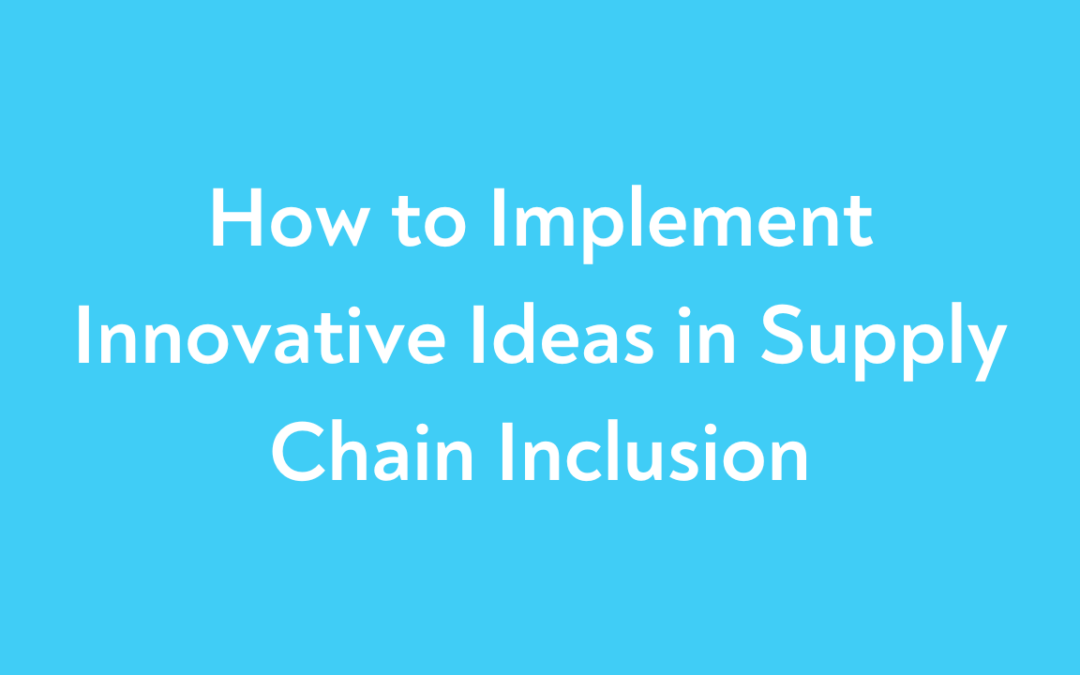In a world where markets are interconnected and consumer preferences evolve rapidly, innovation becomes the lifeblood of any business. It’s no different for supply chain management, especially when considering the concept of supplier diversity and inclusion. Advancements in technology, shifts in socioeconomic dynamics, and a growing awareness around the importance of diversifying your supplier base are continuously reshaping the narrative around supply chain inclusion. As we navigate this evolving landscape, the ability to generate and implement innovative ideas is essential. Let’s dive into how we can bring innovation to the forefront of supply chain inclusion and harness its potential.
Creating a Pipeline for Innovative Ideas
Innovation doesn’t occur in a vacuum – it requires a culture that encourages questioning the status quo, exploring new possibilities, and valuing diverse perspectives. Establishing such a culture within your organization is the first step towards generating innovative ideas.
Regular brainstorming sessions involving cross-functional teams, supplier diversity training programs, and open platforms for employees, suppliers, and stakeholders to voice their thoughts and suggestions can all contribute to a healthy pipeline of innovative ideas. These efforts can be further bolstered by actively seeking insights from marginalized suppliers themselves, who can provide first-hand knowledge of the barriers to inclusion and suggest practical solutions.
Implementing Innovation in the Supply Chain
Once a steady stream of innovative ideas is established, the next step is implementation. This process involves taking calculated risks and being ready to learn and adapt. Here are a few strategies to consider:
- Pilot Programs: Before implementing a new idea across the entire supply chain, consider running a pilot program. This allows you to test the idea, identify any shortcomings, and tweak it as necessary before a full-scale rollout.
- Stakeholder Engagement: Communication and collaboration are critical when implementing new ideas. Engage with all relevant stakeholders—internal teams, suppliers, customers, and community representatives—to ensure that everyone understands the change and is on board.
- Leverage Technology: Utilize technology to facilitate the implementation of new ideas. Digital platforms can connect businesses with diverse suppliers, AI can help in decision-making, and data analytics can provide valuable insights into the effectiveness of the new measures.
- Continuous Monitoring and Improvement: The work doesn’t end once a new idea is implemented. Regular monitoring and evaluation are crucial to assess the impact of the innovation and to make continuous improvements.
The Power of Flexibility and Continuous Growth
Innovation requires a mindset of flexibility and continuous growth. As the market landscape changes, businesses must be ready to pivot and adapt. A good example of this is the recent global pandemic, which led many companies to reimagine their supply chains. Companies that had cultivated a culture of innovation and flexibility were able to pivot more quickly, strengthening their supplier diversity and inclusion amid the crisis.
Johnson & Johnson, which has been recognized for its innovative supplier diversity program, leveraged technology to create a Supplier Diversity Dashboard, a tool that provides real-time data on supplier diversity and aids in decision-making. They also launched a capacity-building program that offers diverse suppliers access to executive education, mentorship, and networking opportunities.
Driving the Modern Marketplace Forward
Innovation in supply chain inclusion not only benefits individual businesses but drives the entire marketplace forward. It allows us to tap into a wider pool of suppliers, fostering competition and promoting economic equity. It also enables businesses to reflect the diversity of their customers and communities, leading to better products, services, and customer relationships.
By nurturing a culture of innovation, we can break down barriers, foster an equitable marketplace, and drive our businesses—and society—towards a more inclusive, prosperous tomorrow.
Key Takeaways:
- Cultivating a culture of innovation within an organization is the first step towards generating innovative ideas for supply chain inclusion. This involves encouraging diverse perspectives, questioning the status quo, and creating open platforms for dialogue.
- Regular brainstorming sessions, supplier diversity training programs, and feedback from marginalized suppliers can contribute to generating innovative ideas for inclusion in the supply chain.
- Implementing these ideas successfully requires strategies such as pilot programs, stakeholder engagement, leveraging technology, and continuous monitoring and improvement.
- Businesses must adopt a mindset of flexibility and continuous growth, remaining ready to adapt and change as market conditions evolve.
- Innovation in supply chain inclusion can drive the entire marketplace forward by promoting economic equity, fostering competition, and enabling businesses to better reflect their diverse customers and communities.


Recent Comments